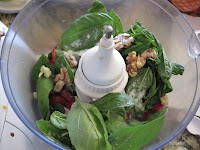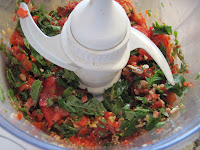I just love homemade pizza. It’s such a familiar dish, and yet it can be completely tailored to your tastes and cravings, which means you can never really get sick of it (or at least C and I can’t). Done simply, with a basic sauce, cheese, and toppings, it’s a quick, easy, and cheap dinner for a busy weeknight. When you add some high quality ingredients or develop a unique flavor combination ((BBQ chicken is always a favorite), it’s completely acceptable to serve to company.
We had pizza for dinner on Friday night. It had been a long week, and I really just wanted to make something that was easy and would taste really good. I had been cooking all kinds of crazy dishes during the week, and on Friday it was time to take a break.
Pizza is the place where leftovers go to be reborn. This week I had some leftover Tomato Roasted Red Pepper Pesto (recipe posted below) and Slow-Roasted Tomatoes that were just begging to be used. These two ingredients sounded like the beginning of a beautiful pizza, and so the dinner was off to a good start.
Crust:
I have made my own crust before, but most of the time I don’t bother. Some may disagree with me here, but I find that making your own pizza dough really just turns a simple meal into a much more time-consuming one. Unless you have some heirloom pizza dough recipe that your grandparents brought over from Italy (my Polish grandparents had no such thing), I’d recommend leaving it to the professionals unless you’re feeling especially adventurous (or bored).
I buy my pizza dough at Trader Joe’s. You can find fresh pizza dough at grocery stores, and I recommend getting fresh dough rather than a pre-baked crust (à la Boboli). Trader Joe's has a whole wheat version that tastes pretty good. Here’s how I get the crust ready:
*Let the crust sit at room temperature for 20 minutes before handling it (you can use that time to get your other ingredients ready and preheat your oven). Get a big cutting board and sprinkle a bunch of flour in the middle. Place the dough in the center of your floured board and sprinkle the top with flour. Then gently start pressing the dough into the shape of a larger disc. You can use a rolling pin to do this, and you might need to with certain doughs, but the Trader Joe’s dough is very soft and easy to do with your hands. Make sure to flip the dough over to the other side a few times and add more flour as needed. Gently work around the edges until your dough is about 12 inches in diameter. Fold it in half so that it’s easier to lift, and then lift it over on to your pizza pan and unfold it so that the dough is centered on the pan. Now you’re ready for sauce.
I know a lot of people like to use those pizza stones. Personally, I’d rather not have to wait for a stone to heat up before I can make my dinner, let alone have some stone sitting around the apartment. I just have a non-stick pizza pan that has always worked well for me. Maybe someday I’ll try the stone, but I’m in no rush.
Sauce:
The simplest sauce that I use is a can of tomato paste with some seasoned salt and red pepper flakes sprinkled on top. It’s so cheap and easy, and it works well for lots of traditional pizza toppings. There are lots of more involved pizza sauce recipes out there to try, but it all depends on how much time and energy you have for cooking that day. Store-bought or homemade pesto is a great option, and I’ve even used bottled BBQ sauce when making a BBQ Chicken Pizza.
This week I had some healthy Tomato Roasted Red Pepper Pesto in the fridge. Most pesto recipes have a lot of olive oil in them, along with nuts and Parmesan cheese, so they tend to be somewhat high in fat and calories. I had got the idea to use tomatoes in pesto from the Moosewood Restaurant site. If you like pesto and want a low-fat, low-calorie version, try this one out.
Tomato Roasted Red Pepper Pesto:
1/2 cup tomatoes, chopped (I used cherry tomatoes that I cut in half)
1/2 cup fresh basil, packed
1/2 cup roasted red peppers (you can roast them yourself or buy roasted peppers in a jar)
1 Tablespoon toasted walnuts
3 cloves garlic
1/2 teaspoon salt
1/4 teaspoon black pepper
1 teaspoon olive oil
Add all your ingredients to a food processor. Process until the ingredients are combined, scraping down the sides of the bowl as necessary. It may take a few times to get a smooth texture to the pesto.
Store in the refrigerator. You can use it as a spread for sandwiches (I think it would be great on a grilled cheese), or use it as a sauce for pasta. If you add some plain yogurt to it, it can make a great creamy pasta sauce.
You'll get about one cup of pesto from this recipe, and the following nutrition facts are for a 1 oz serving, which is about 2 Tablespoons.
| Nutrition Facts | ||||||
Serving Size 31 g | ||||||
Amount Per Serving | ||||||
Calories 25 Calories from Fat 16 | ||||||
% Daily Value* | ||||||
Total Fat 1.8g 3% | ||||||
Cholesterol 0mg 0% | ||||||
Sodium 98mg 4% | ||||||
Total Carbohydrates 1.7g 1% | ||||||
Dietary Fiber 0.6g 2% | ||||||
Protein 0.5g | ||||||
|
Toppings:
Toppings are where you can really get creative. Use what you have, or get some nice fresh tomatoes and basil and keep it simple. It's really up to you.
Cheese:
Mozzarella and Parmesan are classics, and there's a reason for that. Try some herbed goat cheese, Gruyère, or Fontina to mix it up. I also like to combine cheeses. I find that it really adds layers of flavor to the pizza. I also like to add some finely shredded Parmesan to pizzas right when they come out of the oven. It melts right into the top of the pizza and adds an extra touch of flavor.
Crust:
I brush the crusts of my pizzas with seasoned olive oil. I just take a small dish, pour some olive oil in it, and then add some seasonings. I generally use seasoned salt, black pepper, cayenne pepper, and garlic powder. If you're using classic basil pesto as your sauce, I recommend adding just a touch of the pesto to your olive oil. Use a pastry brush to spread the olive oil on your crust after you've finished adding your sauce and toppings. This is an extra step, but I think it's totally worth it.
Cooking:
When you're baking pizza in a normal oven, it's really important to use a really high temperature. Don't follow the directions on the Trader Joe's pizza dough package. It will tell you to cook the pizza at 350 degrees, which will produce a horribly undercooked pizza. It's bad. Just take my word for it.
I cook pizzas at a temperature that's between 450 and 500 degrees for exactly 12 minutes. If you like your crust a little crisper, go for 500 degrees. If you like it a little softer, stick with 450. It's a matter of personal preference.
I highly recommend grilling pizza. I no longer have a BBQ, but when I did, I LOVED grilled pizza in the summer. It's such a quick process, so you really have to be on top of your game. There's a Washington Post article that has a dough recipe and cooking instructions. If you buy your dough, you can still use the grilling instructions.
Popular combinations:
I am not going to tell you what to put on your pizza, but if you'd like a bit if inspiration, these are some combinations that we've really enjoyed in the past.
- Pesto Pizza with homemade or store-bought pesto, spinach, tomatoes, mozzarella, and parmesan
- BBQ Chicken Pizza with BBQ sauce, cooked chicken, corn or corn salsa, red onion, mozarella, and herbed goat cheese
- Chicken Parmesan Pizza with tomato paste, cooked chicken, spinach, mozzarella, and parmesan
These are just to get you started. Let the crust be your canvas and spend the money that you saved on delivery on a nice bottle of wine.












No comments:
Post a Comment